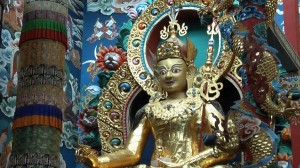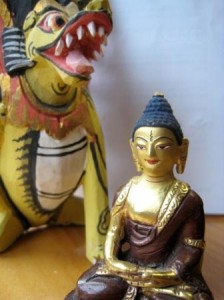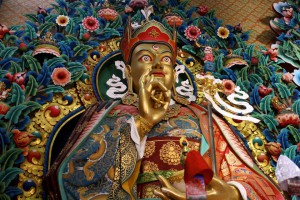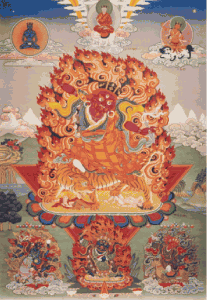Sunday
Dharma TeachingsSupplication to Padmasambhava 2
Continuing our look at a supplication chant to Guru Rinpoche
by Russell Rodgers
O Jetsün Guru Rinpoche,
Refuge of all beings in the three realms, Consider your vow.
Dispel outer, inner and secret obstacles.
Jetsün is an honorific term for especially revered gurus. The three realms refer to the realm in which we live, and the form and formless god realms. These latter two are accessed in some meditation experiences, but are regarded as not being particularly spiritually relevant to our path.
Outer obstacles are obstacles in the environment, such as not having enough money to attend a dharma program. Inner obstacles refer to the physical sicknesses and conflicting emotions that happen in one’s own person. Secret obstacles have to do with the loss of one’s awareness of sacred outlook. When this loss happens, one can fall into confused projections of self and other, friend and enemy, good and bad.
When the pure four truths are propagated…..
The pure four truths refer to the “Four Noble Truths”: The first is the truth that the human condition is marked by perpetual dissatisfaction, suffering and anxiety. The second refers to the source of that condition: the belief in a self and the web of concepts that are created around that. The third truth is that one is sometimes released momentarily, just long enough so that one realizes that suffering, anxiety and dissatisfaction are unnecessary. The fourth is the truth of the path: how to stabilize that release from suffering.
If misfortunes of malicious maras arise….
Maras are seductive spirits: personifications of four basic neurotic tendencies. First is skandha-mara, the seduction of belief in a solid, permanent, unitary self. Klesha-mara refers to the seduction of confused emotions, and believing them to be the truth about reality. Devaputra-mara is the unbalanced pursuit of pleasure and accompanying ignorance of the signals of pain. Attachment to blissful states of meditation is part of this mara. Yama-mara is death, which interrupts one’s practice unless one knows how to include death as path. This mara is also connected with the fear of death, or simply the fear of losing reference points and experiencing groundlessness. Losing ground, or the fear of it, is at the root of much neurosis.
O Guru Shakya Senge,
Dispel outer, inner, and secret obstacles.
Padmasambhava had different names at different periods of his life. These names reflected the kind of energy that he was manifesting at that time. Shakya Senge (Tibetan for “lion of the Shakya clan”) was the name that he was given when he received ordination. Although he was said to be enlightened from birth, in this phase he demonstrated the importance of relating to the monastic tradition. As Shakya Senge, he appears in iconography wearing monk’s robes, sitting in lotus posture, holding a begging bowl in his left hand and a vajra in the right. Sakya Senge shows Guru Rinpoche’s mastery and protection of the foundation teachings of the dharma.
When the bodhichitta path of aspiring and entering is propagated,
If there arise misfortunes of mãras causing one to harm others,
The bodhichitta path refers to the Mahayana. At first we “aspire” to awaken our hearts towards others. This aspiration is formalized with the bodhisattva vow. We actually “enter” that path when we begin to practice the six paramitas. The paramitas are practices based on enlightened activities. Our basic inspiration may come from a brief glimpse of natural, spontaneous awakened heart, but our practice of that may feel somewhat awkward and artificial because we have conceptualized projection of what compassion and emptiness are. Through practice, we get closer and gradually “enter” into genuine, spontaneous, non-conceptual awakened heart. At this point, we are able to practice the paramitas fully.
O Guru Loden Choksi,
Dispel outer, inner, and secret obstacles.
The name “Loden Choksi” was given to Padmasambhava after he had studied under many vajra masters and accomplished many Vajrayana practices. He became the guru of the king of Sahor in India. Loden Choksi is depicted in royal robes, wearing a white turban on his head and a mirror around his neck. Through his miraculous ability to deal with whatever threats, difficulties, and obstacles arose, Loden Choksi manifested invincibility. Whatever obstacles arose, these became adornments for him.
When the chariot of vajrayãna
Is brought into the world,
If the perverted aspirations of barbarians run rampant…..
The Vajrayana teachings are powerful: they accept the world as it is, within self- existing sacredness and non-ego. Sometimes people pervert these teachings out of a desire to capture the power of Vajrayana by twisting the teachings to enhance ego. One common way to twist the teachings is to say that since everything is sacred, it doesn’t matter what one does. In this case, there is usually a lot of ego happening on the side of the person doing the action, and a lack of understanding of karma and compassion. In this case sacredness or basic goodness is not based on pure nowness, but on a concept of sacredness or basic goodness.
….O Guru Dorje Trolö,
Dispel outer, inner, and secret obstacles.
Dorje Trolö is a wrathful manifestation of Padmasambhava, with a red face and three eyes, biting his lower lip with his fangs, wielding a vajra in his right hand and a phurba (three bladed dagger) in his left, standing on a pregnant tigress. Both he and Senge Dradrok are crazy wisdom forms; they transmute the poisonous confusion of samsara into spontaneous wisdom activity. In The Sadhana of Mahamudra, the form and the activity of Dorje Trolö is unified with that of Karma Pakshi, the second Karmapa. Dorje Trolö is the form that Padmasambhava manifested when he came to Tibet and encountered Tibetan religion and culture, which was much more earthy than the Indian religion of the time. However, that culture still had a dualistic relationship between man and the gods, and between man and the external world. Dorje Trolö, because he lived in non-duality himself, exploded this duality through his own example. He also left “terma,” teachings that were not appropriate during his time, but would be at a later date. The Vidyadhara found several of these in the form of yellow scrolls when he was still a teenager in Tibet. The Sadhana of Mahamudra is an example of a terma, although the Vidyadhara discovered it without the aid of a written text.
When the three yãnas of the excellent Great Eastern Sun Are propagated and established,
If mãra-hordes of gyalgongs and senmos gather,
O Guru Senge Dradok,
Dispel outer, inner, and secret obstacles.
Usually, the three yãnas refer to the Hinayana, Mahayana and Vajrayana. Putting them in the context of the “Great Eastern Sun” highlights these in a different light. In this case it refers to the Shambhala teachings for creating an enlightened society, based on fundamental human dignity and wisdom. Guru Senge Dradok (Tibetan for “Lion’s Roar”): is another wrathful manifestation of Padmasambhava. He appears as a defender of the dharma and great magician: dark blue, with three eyes, fangs, trampling on human corpses, wearing a tiger skin skirt, hair streaming upwards, with a crown of five small skulls and a necklace of human heads, surrounded by flames of wisdom and wrathful compassion.
Trungpa Rinpoche commented that, when presented with a problem based on some kind of misunderstanding of reality, Senge Dradruk was not afraid to meet those who were presenting the problem, on their own ground. He did not try to block them. Instead, mixing his presence with theirs had the effect of accelerating the natural course of problem towards dissolution. This happens because confusion is based on concepts, and concepts need to be maintained by effort in the face of actual reality. Since he was not attached to the “this-ness” of himself, he wasn’t afraid of the “that-ness” of the world. The chant specifically mentions gyalgongs, or “monk demons,” who provoke competitive aggression by perverting the dharma with their analytical preconceptions. They transform dharmic vision into politics and sectarian strife. Senmos are female demons who seduce the practitioner into samsaric passion through sensual fascination.
You bound by oath devas and rãkshasas,
Consider well your former vow of compassion.
Destroy outer, inner, and secret obstacles.
Dispel the döns who bring darkness to the world.
Samye was the first monastery built in Tibet. During the building of the monastery, there were many misfortunes and obstacles. It seemed as though what was built in the day was being dismantled at night by devas and rãkshasas –gods and demons. Padmasambhava was invited to turn things around, and he did it in such a way that the environmental situation began to work for, rather than against the building of the monastery. Hepo Hill is near Samye, where Padmasambhava tamed the local deities who were interfering with the establishment of dharma in Tibet. Döns are malicious spirits whose attacks are associated with lack of mindfulness on the part of the practitioner.
O Mahaguru, compassionate one,
There is no other hope but you.
Please issue your command to the ocean of dharmapãlas
So they will destroy all obstacles without exception.
Because Padmasambhava had tamed the obstructing spirits and energies to the service of the dharma, they became dharmapãlas, or protectors of teachings. We might wonder what that means for our own culture.
 Russell Rodgers has been wondering about this kind of topic for the 39 years that he has been practicing. He resides in the Kootenay mountains of British Columbia, in the town of Nelson, and has graciously agreed to allow publication of his beautiful essays on the Shambhala chants here in the Times.
Russell Rodgers has been wondering about this kind of topic for the 39 years that he has been practicing. He resides in the Kootenay mountains of British Columbia, in the town of Nelson, and has graciously agreed to allow publication of his beautiful essays on the Shambhala chants here in the Times.









Jun 23, 2017
Reply
Thank you for this wisdom and for your other interpretations of our chants.
I find these to be helpful and enlightening.